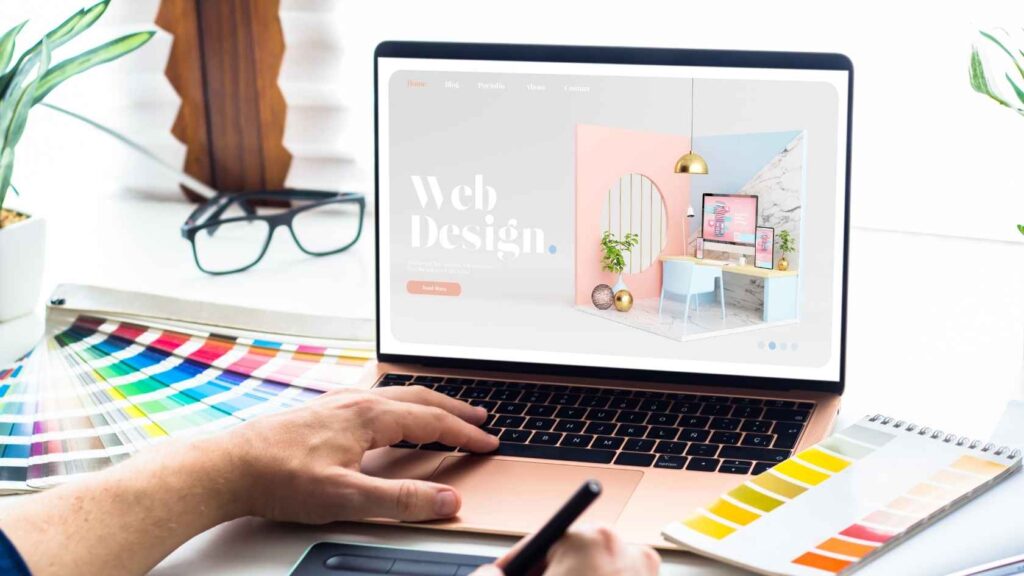In today’s digital world, web designers have become indispensable. With businesses, big and small, moving online, the demand for skilled web designers is skyrocketing. If you’re looking to secure a job in this fast-growing field, preparing for your interview is crucial. Web design interviews are not just about understanding the basics of design. They delve into technical expertise, creativity, and problem-solving abilities.
So, what exactly does a web designer do, and why is this role becoming so critical?
Web designers are the creative minds behind the websites you interact with daily. They ensure websites are not only aesthetically pleasing but also user-friendly, functional, and in line with a brand’s message. Whether it’s crafting engaging landing pages, optimizing site navigation, or making sure a site works perfectly across devices, web designers are at the heart of the user experience.
If you’re preparing for a web design interview, it’s essential to know what to expect. This guide breaks down 30 web design interview questions into three categories: for freshers, intermediate designers, and advanced professionals. We’ve also provided sample answers and key insights for each level to help you feel confident during your interview.
Fresher-Level Web Design Interview Questions

1. What is web design?
Answer:
Web design is the process of creating websites that are visually appealing, functional, and user-friendly. It involves several aspects, including layout, color schemes, fonts, and images, as well as the technical aspect of coding in languages like HTML, CSS, and JavaScript.
2. What’s the difference between UX and UI design?
Answer:
User Experience (UX) focuses on the overall feel of the experience. It’s about how easy and enjoyable it is for users to navigate a site. User Interface (UI) design is more about the actual layout and how the content is presented to the user, including buttons, menus, and forms.
3. Can you explain what HTML and CSS are?
Answer:
HTML (HyperText Markup Language) is used to structure content on the web, such as headings, paragraphs, and images. CSS (Cascading Style Sheets) is used to control the layout and presentation of this content, such as fonts, colors, and spacing.
4. What’s the difference between a responsive and adaptive design?
Answer:
Responsive design adjusts the layout automatically depending on the screen size or orientation, ensuring the site looks good on all devices. Adaptive design, on the other hand, uses multiple fixed layouts, and the best one is selected based on the screen size.
5. What is a wireframe in web design?
Answer:
A wireframe is a blueprint or sketch of a webpage that outlines where content, images, and navigation elements will be placed. It’s often one of the first steps in the web design process to plan the structure of a site before adding visual elements.
6. Which design software tools are you familiar with?
Answer:
Some of the popular design tools include Adobe XD, Sketch, Figma, and Photoshop. These tools allow web designers to create mockups, prototypes, and high-fidelity designs efficiently.
7. What is the purpose of a content management system (CMS)?
Answer:
A CMS allows users to create, edit, and manage website content without needing to code. Popular CMS platforms include WordPress, Joomla, and Drupal.
8. How do you approach designing a website for accessibility?
Answer:
Accessibility in web design means creating a site that can be used by everyone, including people with disabilities. This includes using proper color contrast, providing alt text for images, and ensuring the site can be navigated via keyboard for those with mobility impairments.
9. What is mobile-first design?
Answer:
Mobile-first design is an approach where the website is designed for mobile devices first and then scaled up for larger screens like tablets and desktops. Given the increasing use of smartphones, this ensures that sites work seamlessly on smaller screens.
10. How do you keep your web design skills up to date?
Answer:
Staying up to date involves regularly following industry blogs, attending webinars, participating in online courses, and experimenting with new tools and trends in web design.
Also read: 30 Social Media Marketing Interview Questions
Intermediate-Level Web Design Interview Questions
11. What’s the difference between fixed, fluid, and responsive layouts?
Answer:
- Fixed layout has a set width and does not change regardless of the screen size.
- Fluid layout uses percentages for widths, allowing elements to resize with the browser window.
- Responsive layout adjusts and optimizes content based on the screen size using CSS media queries.
12. How would you optimize a website’s load speed?
Answer:
Website load speed can be optimized by compressing images, minifying CSS and JavaScript files, leveraging browser caching, using content delivery networks (CDNs), and minimizing HTTP requests.
13. Can you explain the box model in CSS?
Answer:
The CSS box model is a fundamental concept that wraps every HTML element in a box. It consists of four areas: content, padding, border, and margin. Understanding the box model is crucial to control the spacing and layout of elements on a webpage.
14. How do you handle browser compatibility issues?
Answer:
To ensure cross-browser compatibility, I use browser-specific prefixes in CSS (e.g., -webkit-, -moz-), test designs in different browsers (Chrome, Firefox, Edge, Safari), and utilize tools like BrowserStack. I also write clean and standards-compliant code to minimize compatibility issues.
15. What are CSS preprocessors, and why are they useful?
Answer:
CSS preprocessors like SASS and LESS allow web designers to use variables, nesting, and functions, which makes writing and maintaining CSS easier and more efficient. They compile into regular CSS that browsers can read.
16. Explain the concept of modular web design.
Answer:
Modular web design involves creating reusable components or modules (like buttons, navigation bars, or forms) that can be repurposed across different parts of the website, improving consistency and maintainability.
17. How would you design for users with limited internet bandwidth?
Answer:
For users with limited bandwidth, I would optimize images, reduce the number of resources (e.g., scripts and stylesheets), implement lazy loading for media, and use a minimalist design approach that prioritizes essential content.
18. How do you incorporate SEO into your web design process?
Answer:
SEO-friendly design includes optimizing images (alt text, file names), ensuring fast load times, using semantic HTML tags, making sure the site is mobile-friendly, and maintaining clean and structured code for easy crawling by search engines.
19. Can you describe a challenging web design project you worked on and how you overcame the obstacles?
Answer:
I worked on a large e-commerce website that needed to be completely redesigned while remaining fully operational. The challenge was ensuring no downtime during the transition. I overcame this by working in phases, thoroughly testing each section on a staging server before deployment.
20. What’s the role of prototyping in web design?
Answer:
Prototyping allows designers to create an interactive model of the website before the actual build. This helps in getting client feedback early, testing user interactions, and identifying potential issues before development starts.
Also Read: Top 40 WordPress Interview Questions
Advanced-Level Web Design Interview Questions
21. How do you design for performance in large-scale web applications?
Answer:
In large-scale applications, performance optimization is key. I design with performance in mind by using techniques like code splitting, lazy loading, optimizing images, and employing caching strategies.
22. Can you explain the concept of Atomic Design in web development?
Answer:
Atomic Design is a methodology for creating design systems, where components are broken down into their smallest parts (atoms). These atoms combine to form molecules, which then build organisms, templates, and ultimately, full pages. This modular approach improves scalability and consistency across a project.
23. How do you balance creativity with usability in web design?
Answer:
Creativity must always serve usability. While innovative design is important, it should not come at the cost of user experience. I balance the two by keeping the end user in mind, prioritizing intuitive navigation and ensuring that the visual elements enhance functionality rather than obstruct it.
24. What strategies do you use for designing web applications that handle high traffic volumes?
Answer:
For high-traffic applications, I use efficient coding practices, optimize databases, implement load balancing, and work with CDNs to distribute content effectively. Ensuring scalability in both design and backend is crucial to maintaining performance under heavy loads.
25. How do you approach A/B testing in web design?
Answer:
A/B testing involves creating two versions of a webpage to test which one performs better based on user behavior. I set clear metrics (like conversion rate or click-through rate) and make small, controlled changes to elements such as CTA buttons, headlines, or images to see which version yields better results.
26. How would you design for progressive web apps (PWAs)?
Answer:
When designing for PWAs, I focus on creating an app-like experience in the browser, ensuring the design works seamlessly offline, loads quickly, and offers a responsive, immersive experience across devices. PWAs also require careful attention to performance optimization and smooth animations.
27. What is your process for conducting a UX audit?
Answer:
A UX audit involves evaluating the user experience of a website or app by identifying pain points and areas of improvement. I review analytics data, conduct user interviews or surveys, and perform usability tests to identify issues. Then, I prioritize these issues based on their impact and work with the team to address them.
28. How do you ensure your web design is GDPR compliant?
Answer:
GDPR compliance requires ensuring that the website protects user data privacy. This involves including clear cookie consent banners, ensuring user data is encrypted, providing easy-to-find privacy policies, and allowing users to opt-in or opt-out of data tracking.
29. How do you keep up with web design trends and emerging technologies?
Answer:
I stay up-to-date by following industry-leading blogs, attending conferences, and participating in online communities. I also experiment with new tools, frameworks, and techniques in my projects to stay at the forefront of web design.
30. What’s your approach to collaborating with developers in a web design project?
Answer:
Collaboration with developers involves clear communication and understanding of both design and technical limitations. I provide detailed design specifications, assets, and guidelines while being open to feedback from developers on what is feasible in terms of functionality.
Quick Tips for Preparing for a Web Design Interview
- Research the company: Understand its design style, the tools it uses, and its target audience.
- Prepare your portfolio: Showcase a diverse range of projects, from simple landing pages to complex web applications.
- Understand the job role: Is it more design-focused, or will you need strong coding skills? Tailor your preparation accordingly.
- Practice common web design tools: Be familiar with design software like Figma, Sketch, Adobe XD, and development tools like Chrome DevTools.
- Review your basics: HTML, CSS, JavaScript, and fundamental design principles are always on the table.
- Stay current with trends: Know the latest in responsive design, UX/UI trends, and performance optimization.
- Mock interviews: Practice answering common web design interview questions with a friend or in front of a mirror to build confidence.
Conclusion
Whether you’re a fresher or an experienced designer, preparing for a web design interview can feel overwhelming. With the right mindset, solid preparation, and a deep understanding of these web design interview questions, you’ll be well-equipped to ace your next job interview and secure your place in the exciting field of web design.
